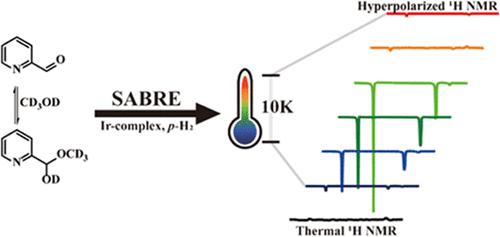当前位置:
X-MOL 学术
›
Anal. Chem.
›
论文详情
Our official English website, www.x-mol.net, welcomes your
feedback! (Note: you will need to create a separate account there.)
Temperature-Sensitive Magnetic Resonance Probes: Leveraging Hyperpolarized Pyridine-2-Carbaldehyde and SABRE for Real-Time Temperature Sensing
Analytical Chemistry ( IF 6.7 ) Pub Date : 2024-11-14 , DOI: 10.1021/acs.analchem.4c04226 Sein Min, Hye Jin Jeong, Sarah Kim, Juhee Baek, Jisu Kim, Jean Chung, Sung Keon Namgoong, Keunhong Jeong
Analytical Chemistry ( IF 6.7 ) Pub Date : 2024-11-14 , DOI: 10.1021/acs.analchem.4c04226 Sein Min, Hye Jin Jeong, Sarah Kim, Juhee Baek, Jisu Kim, Jean Chung, Sung Keon Namgoong, Keunhong Jeong

|
In this study, we developed a novel approach for real-time, temperature-sensitive nuclear magnetic resonance (NMR) measurements using signal amplification by reversible exchange (SABRE). We discovered that pyridine-2-carbaldehyde (A) exhibits different behavior depending on temperature, showing high hyperpolarization efficiency. In contrast, its reversible reaction product, the hemiacetal form (A′), is not affected by temperature. Exploiting this difference, we achieved a reliable polarization enhancement ratio without internal standard materials, even at low concentrations. Our method overcomes challenges associated with SABRE for 2-functionalized pyridines, enabling direct temperature monitoring in real-time NMR studies. We successfully applied it to monitor temperatures in solutions containing SABRE-inactive compounds like caffeine. Furthermore, we demonstrated its efficacy using a 60 MHz benchtop NMR spectrometer, validating its potential in challenging environments where conventional techniques may be limited. This technique shows promise for influencing the magnetic resonance field, potentially facilitating more accurate real-time analyses of molecular reactions and structures. Future research will focus on adapting this method for biological settings, aiming to stimulate advancements in NMR and magnetic resonance imaging (MRI) applications.
中文翻译:

温度敏感磁共振探头:利用超极化吡啶-2-氨基甲醛和 SABRE 进行实时温度传感
在这项研究中,我们开发了一种使用可逆交换信号放大 (SABRE) 进行实时、温度敏感核磁共振 (NMR) 测量的新方法。我们发现吡啶-2-甲醛 (A) 根据温度表现出不同的行为,表现出高超极化效率。相比之下,其可逆反应产物半缩醛形式 (A′) 不受温度影响。利用这一差异,即使在低浓度下,我们也无需内标材料即可获得可靠的极化增强比。我们的方法克服了与 SABRE 对 2 官能化吡啶相关的挑战,从而能够在实时 NMR 研究中直接监测温度。我们成功地将其应用于监测含有 SABRE 非活性化合物(如咖啡因)的溶液中的温度。此外,我们使用 60 MHz 台式 NMR 波谱仪证明了它的功效,验证了它在传统技术可能受限的挑战性环境中的潜力。这项技术有望影响磁共振场,从而可能有助于更准确地实时分析分子反应和结构。未来的研究将侧重于将这种方法应用于生物环境,旨在促进 NMR 和磁共振成像 (MRI) 应用的进步。
更新日期:2024-11-14
中文翻译:

温度敏感磁共振探头:利用超极化吡啶-2-氨基甲醛和 SABRE 进行实时温度传感
在这项研究中,我们开发了一种使用可逆交换信号放大 (SABRE) 进行实时、温度敏感核磁共振 (NMR) 测量的新方法。我们发现吡啶-2-甲醛 (A) 根据温度表现出不同的行为,表现出高超极化效率。相比之下,其可逆反应产物半缩醛形式 (A′) 不受温度影响。利用这一差异,即使在低浓度下,我们也无需内标材料即可获得可靠的极化增强比。我们的方法克服了与 SABRE 对 2 官能化吡啶相关的挑战,从而能够在实时 NMR 研究中直接监测温度。我们成功地将其应用于监测含有 SABRE 非活性化合物(如咖啡因)的溶液中的温度。此外,我们使用 60 MHz 台式 NMR 波谱仪证明了它的功效,验证了它在传统技术可能受限的挑战性环境中的潜力。这项技术有望影响磁共振场,从而可能有助于更准确地实时分析分子反应和结构。未来的研究将侧重于将这种方法应用于生物环境,旨在促进 NMR 和磁共振成像 (MRI) 应用的进步。































 京公网安备 11010802027423号
京公网安备 11010802027423号